Module4Unit1 We’vegot lots of apples.教案
- 格式:doc
- 大小:47.00 KB
- 文档页数:4
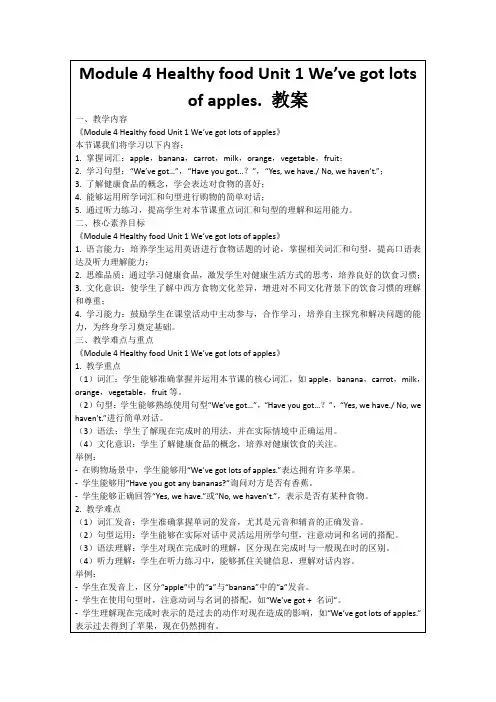
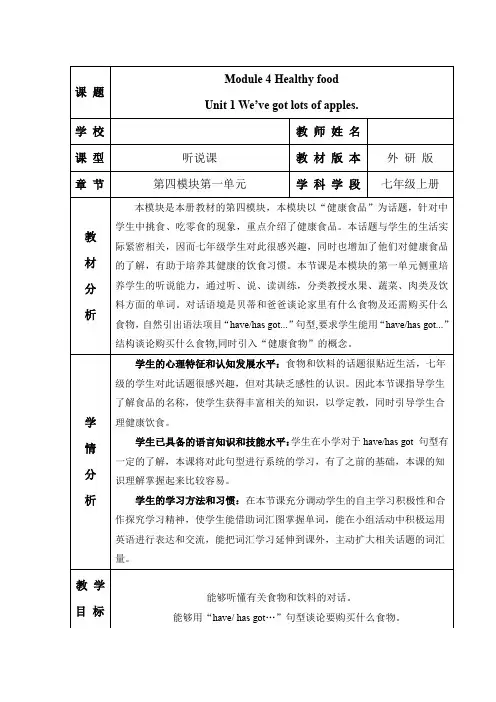
教学课题: Module 4 Healthy foodUnit 1 We’ve got lots of apples.课标分析《英语课程标准》指出:“学生的发展是英语课程的出发点和归宿。
”英语课程在目标设定、教学过程设计、课程评价和教学资源的开发等方面都应突出以学生为主体的思想。
课程实施应成为学生在教师指导下构建知识、提高技能、磨砺意志、活跃思维、发展个性、发展心智和拓展视野的过程。
学生的心理特征和认知发展水平:食物和饮料的话题很贴近生活,七年级的学生对此话题很感兴趣,但对其缺乏感性的认识。
因此本节课指导学生了解食品的名称,使学生获得丰富相关的知识,以学定教,同时引导学生合理健康饮食。
学生已具备的语言知识和技能水平:学生在小学对于have/has got 句型有一定的了解,本课将对此句型进行系统的学习,有了之前的基础,本课的知识理解掌握起来比较容易。
学生的学习方法和习惯:在本节课充分调动学生的自主学习积极性和合作探究学习精神,使学生能借助词汇图掌握单词,能在小组活动中积极运用英语进行表达和交流,能把词汇学习延伸到课外,主动扩大相关话题的词汇量。
教学课题: Module 4 Healthy foodUnit 1 We’ve got lots of apples.效果分析总体而言,本节课的设计体现了以教师为主导、学生为主体,以对话为载体、以培养学生的听说能力为重点的教学思想。
教师以探究任务引导学生自学自悟的方式,提供了学生自主合作探究的舞台,营造了听说和思考的空间,在听懂过程中,培养了学生观察、探究、合作、归纳的能力。
基于以上设计,通过本节课的学习学生能辨别have/has got句型,能够读懂有关健康饮食的文章。
在导入环节,让学生观看有关水果的动画视频以及苹果图片和实物,既能自然导入本课内容,又能创设轻松愉快的情境,引起学生的好奇心,同时激发学生学习的兴趣。
在讲授新单词环节,通过实物、蒙层图片、趣味分类、分组竞赛游戏的多样形式引导学生更生动形象直观的学习新单词,将知识融入活动中,激发了学生的学习兴趣,极大的调到了学生的参与意识,同时为下文的听力练习做铺垫。
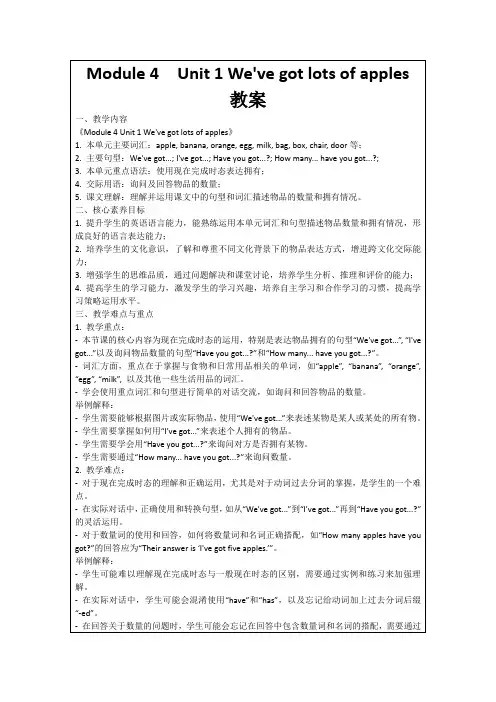
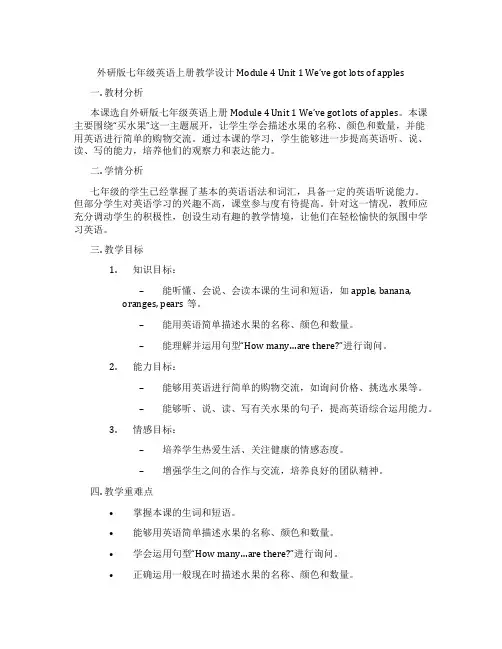
外研版七年级英语上册教学设计Module 4 Unit 1 We’ve got lots of apples一. 教材分析本课选自外研版七年级英语上册Module 4 Unit 1 We’ve got lots of apples。
本课主要围绕“买水果”这一主题展开,让学生学会描述水果的名称、颜色和数量,并能用英语进行简单的购物交流。
通过本课的学习,学生能够进一步提高英语听、说、读、写的能力,培养他们的观察力和表达能力。
二. 学情分析七年级的学生已经掌握了基本的英语语法和词汇,具备一定的英语听说能力。
但部分学生对英语学习的兴趣不高,课堂参与度有待提高。
针对这一情况,教师应充分调动学生的积极性,创设生动有趣的教学情境,让他们在轻松愉快的氛围中学习英语。
三. 教学目标1.知识目标:–能听懂、会说、会读本课的生词和短语,如apple, banana, oranges, pears等。
–能用英语简单描述水果的名称、颜色和数量。
–能理解并运用句型“How many…are there?”进行询问。
2.能力目标:–能够用英语进行简单的购物交流,如询问价格、挑选水果等。
–能够听、说、读、写有关水果的句子,提高英语综合运用能力。
3.情感目标:–培养学生热爱生活、关注健康的情感态度。
–增强学生之间的合作与交流,培养良好的团队精神。
四. 教学重难点•掌握本课的生词和短语。
•能够用英语简单描述水果的名称、颜色和数量。
•学会运用句型“How many…are there?”进行询问。
•正确运用一般现在时描述水果的名称、颜色和数量。
•在实际情境中运用英语进行购物交流。
五. 教学方法1.情境教学法:通过设定水果店这一情境,让学生在真实的购物环境中学习英语。
2.交际法:引导学生运用英语进行购物交流,提高他们的实际应用能力。
3.任务型教学法:通过完成各种任务,激发学生的学习兴趣,培养他们的合作精神。
六. 教学准备1.教学课件:制作含有水果图片、动画和视频的教学课件。
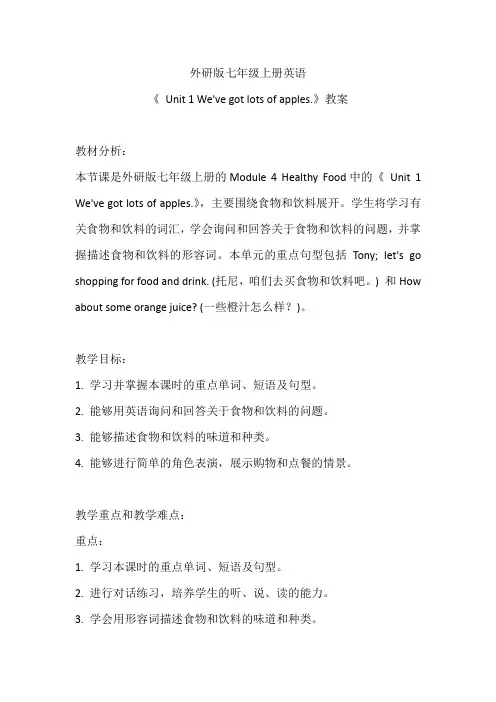
外研版七年级上册英语《Unit 1 We've got lots of apples.》教案教材分析:本节课是外研版七年级上册的Module 4 Healthy Food中的《Unit 1 We've got lots of apples.》,主要围绕食物和饮料展开。
学生将学习有关食物和饮料的词汇,学会询问和回答关于食物和饮料的问题,并掌握描述食物和饮料的形容词。
本单元的重点句型包括Tony; let's go shopping for food and drink. (托尼,咱们去买食物和饮料吧。
) 和How about some orange juice? (一些橙汁怎么样?)。
教学目标:1. 学习并掌握本课时的重点单词、短语及句型。
2. 能够用英语询问和回答关于食物和饮料的问题。
3. 能够描述食物和饮料的味道和种类。
4. 能够进行简单的角色表演,展示购物和点餐的情景。
教学重点和教学难点:重点:1. 学习本课时的重点单词、短语及句型。
2. 进行对话练习,培养学生的听、说、读的能力。
3. 学会用形容词描述食物和饮料的味道和种类。
难点:1. 区分和运用句型中的不同表达方式。
2. 理解和运用形容词的比较级和最高级。
3. 进行角色表演,提高口语表达能力。
学情分析:学生已经具备一定的英语基础,能够进行简单的问答和对话。
他们对食物和饮料有一定的了解,并能描述它们的味道和种类。
然而,学生可能会在区分和运用句型中的不同表达方式以及形容词的比较级和最高级方面存在困难。
教学过程:Step 1: Warm-up教师展示一些食物和饮料的图片,引导学生回顾和复习已学的单词。
T: Good morning, everyone! I'm glad to see you all today. Let's warm up by talking about food and drinks. Look at these pictures on the screen. Can you tell me the names of these items?(学生回答,教师可辅助引导)T: Excellent! You did a great job identifying the food and drinks. Now, let's move on to our lesson for today.Step 2: Presentation教师通过图片和实物的展示,教授新词汇和句型,并进行语音、语调的模仿练习。
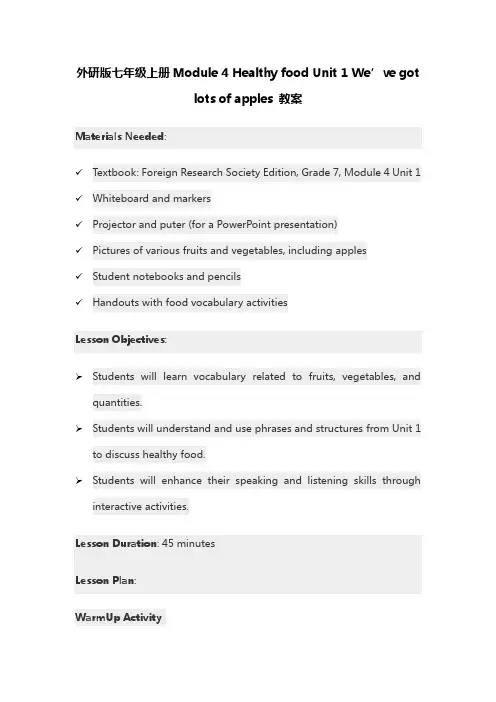
外研版七年级上册Module 4 Healthy food Unit 1 We’ve gotlots of apples 教案Materials Needed:✓Textbook: Foreign Research Society Edition, Grade 7, Module 4 Unit 1✓Whiteboard and markers✓Projector and puter (for a PowerPoint presentation)✓Pictures of various fruits and vegetables, including apples✓Student notebooks and pencils✓Handouts with food vocabulary activitiesLesson Objectives:➢Students will learn vocabulary related to fruits, vegetables, and quantities.➢Students will understand and use phrases and structures from Unit 1 to discuss healthy food.➢Students will enhance their speaking and listening skills through interactive activities.Lesson Duration: 45 minutesLesson Plan:WarmUp Activity1)Start with a general discussion about favorite fruits and vegetables.2)Show pictures of different fruits and vegetables, including apples,and ask students to name them.Vocabulary Introduction(1)Introduce key vocabulary from the unit, focusing on names of fruits,vegetables, and expressions of quantity (like "lots of," "many,""some").(2)Use pictures and realia (if available) to make the vocabulary learningmore engaging.(3)Have students practice pronunciation and repeat after you. Textbook Reading1)Ask students to open their textbooks to Unit 1.2)Read the dialogue "We’ve got lots of apples" aloud, and havestudents follow along.3)Discuss any new words or phrases, ensuring students understandtheir meaning and usage.Interactive Activity(1)Distribute handouts with matching and fillintheblank activitiesrelated to the unit's vocabulary.(2)Students will match pictures of foods with their names and pletesentences using the correct quantity expressions.Group Discussion1)Divide the class into small groups.2)Each group discusses their favorite healthy foods and why they likethem, using the vocabulary and structures learned.PowerPoint Presentation(1)Show a PowerPoint presentation with images and phrases abouthealthy eating.(2)Include examples of sentences from the unit, reinforcing thevocabulary and sentence structures.Review and Homework Assignment1)Quickly review the key vocabulary and phrases from the unit.2)For homework, assign students to write a short paragraph abouttheir favorite healthy meal, using the new vocabulary and expressions.3)Conclude the lesson with positive feedback on their engagement.Homework:Write a paragraph about your favorite healthy meal, including details about the fruits and vegetables involved and using vocabulary from the lesson.Assessment:✧Participation in class discussions and activities.✧Evaluate the homework assignments for correct use of vocabularyand sentence structures.。
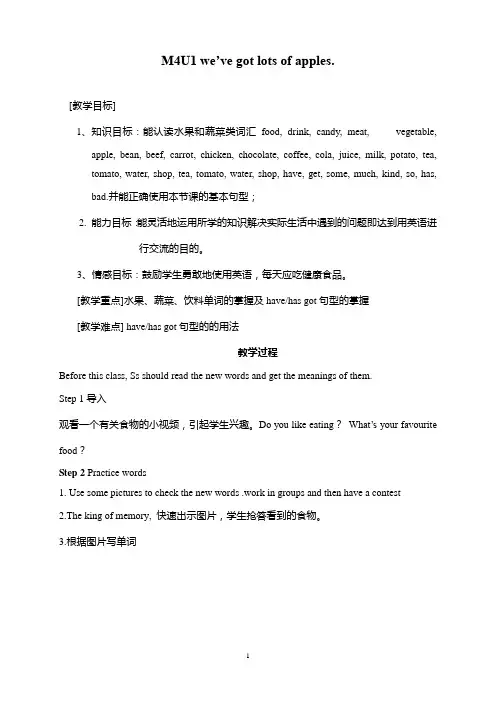
M4U1 we’ve got lots of apples.[教学目标]1、知识目标:能认读水果和蔬菜类词汇food, drink, candy, meat, vegetable,apple, bean, beef, carrot, chicken, chocolate, coffee, cola, juice, milk, potato, tea, tomato, water, shop, tea, tomato, water, shop, have, get, some, much, kind, so, has, bad.并能正确使用本节课的基本句型;2. 能力目标:能灵活地运用所学的知识解决实际生活中遇到的问题即达到用英语进行交流的目的。
3、情感目标:鼓励学生勇敢地使用英语,每天应吃健康食品。
[教学重点]水果、蔬菜、饮料单词的掌握及have/has got句型的掌握[教学难点] have/has got句型的的用法教学过程Before this class, Ss should read the new words and get the meanings of them.Step 1导入观看一个有关食物的小视频,引起学生兴趣。
Do you like eating?What’s your favourite food?Step 2 Practice wordse some pictures to check the new words .work in groups and then have a contest2.The king of memory, 快速出示图片,学生抢答看到的食物。
3.根据图片写单词4.apple beef carrot chicken juice banana milk onion orange pork potato tomato water melon这些单词能分成几类,你会分吗,加油!(小组合作)5. carrots juice onions water milk melons tomatoes an apple beef pork chicken(鸡肉)chickens(小鸡)potatoes an orange orange(橘汁)Countable_______________________________________________________________ Uncountable_____________________________________________________________ 6.判断对错some juice () a onion()a milk () a pork()some potato() a melon()a beef()some tomato()a glass of juice()Step 3 listening and thinking1、Check (√)the food and drink Betty and her mother have got.2、listen to the conversation and answer the questions.(1). Is too much chocolate good for our healthy?(2). Have they got lots of apples?(3). Has Tony’s mum got any coffee?(4). What kind of meat do they get?(5). Has Tony got any cola?3. listen to it again and complete the table.Step 4 Reading time1.Let’s enjoy reading. 播放课文flash. 学生跟读课文2.Underline(画线) some key phrases and the entences with ‘have/ has got’3.小组合作,总结have got的用法1. have got 意为__________, 当主语是第三人称单数时have got 要变成___________。
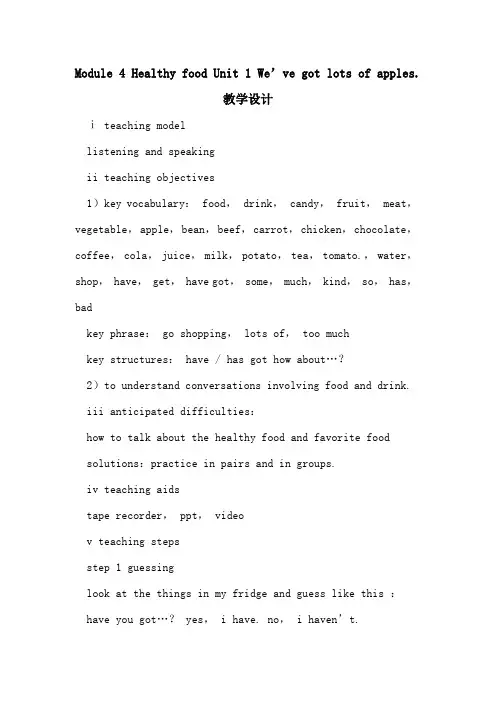
Module 4 Healthy food Unit 1 We’ve got lots of apples.教学设计ⅰ teaching modellistening and speakingii teaching objectives1)key vocabulary: food, drink, candy, fruit, meat,vegetable, apple, bean, beef, carrot, chicken, chocolate,coffee, cola, juice, milk, potato, tea, tomato., water,shop, have, get, have got, some, much, kind, so, has,badkey phrase: go shopping, lots of, too muchkey structures: have / has got how about…?2)to understand conversations involving food and drink. iii anticipated difficulties:how to talk about the healthy food and favorite food solutions:practice in pairs and in groups.iv teaching aidstape recorder, ppt, videov teaching stepsstep 1 guessinglook at the things in my fridge and guess like this :have you got…? yes, i have. no, i haven’t.then the students can present some words about food that they knowstep2 label the words1. look at the pictures. label the food and drink.2. read the words after the teacher.step3 listening (activity4)1.pre-listening :read the words first.2. listen, then they can check their answer with a partner.3 ask the students to remember and write words they learn in groups.step4 listen and read.(activity5)1. guess: what have tony and his father got?2. watch the video and talk about the food.3.read the conversation and act it out.4. complete the table.1. ask the students to complete the table.things tony’s family hasgot at home. things tony’s family hasn’tgot at home.fooddrink5.ask the students to talk about tony’s shopping.— has he got any chicken?no, he hasn’t.step 5 listen and repeat.1. play the recording once without stopping.2. play the recording again and stop at the end of each line. ask the whole class to repeat.3. ask the students to practice the sounds in pairs. step6 work in pairs.make a shopping list. ask and say what you’ve got.1. work in pairs. --- have we got any…?--- yes, we have. we’ve got some…/ no, we haven’t.2. read through the example with the class.3. act them outstep76summarysummary the words and sentence structure learnt today. vi homeworkread and act out the dialogue in activity 5summary the food and drink (countable nouns and uncountable nouns)blackboard design---have you got fruit (apple)vegetable (carrot bean potato tomato)meat (chicken)drink (juice milk tea water)---yes, i have. i have got some…no, i haven’t . i haven’t got any,,,。
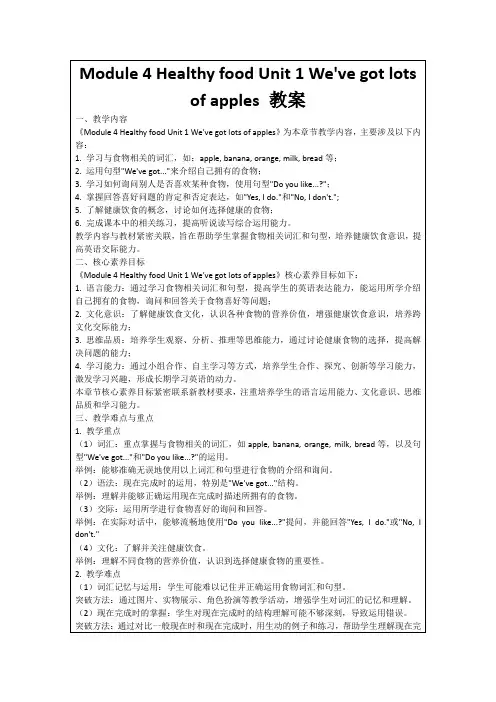
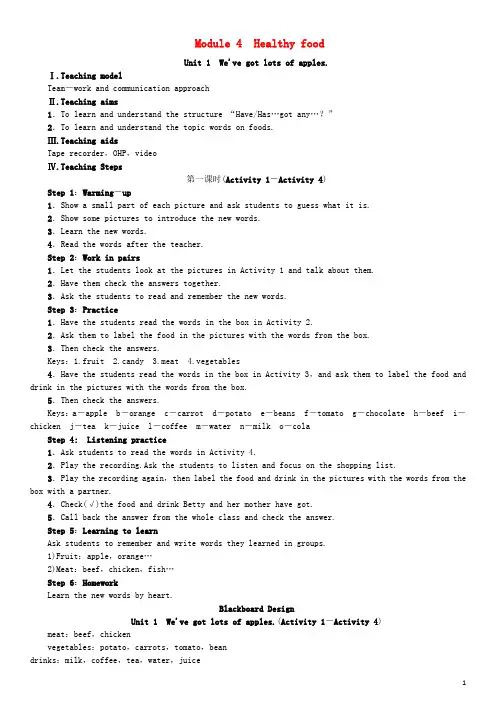
Module 4 Healthy foodUnit 1We've got lots of apples.Ⅰ.Teaching modelTeam-work and communication approachⅡ.Teaching aims1.To learn and understand the structure “Have/Has…got any…?”2.To learn and understand the topic words on foods.Ⅲ.Teaching aidsTape recorder,OHP,videoⅣ.Teaching Steps第一课时(Activity 1-Activity 4)Step 1:Warming-up1.Show a small part of each picture and ask students to guess what it is.2.Show some pictures to introduce the new words.3.Learn the new words.4.Read the words after the teacher.Step 2:Work in pairs1.Let the students look at the pictures in Activity 1 and talk about them.2.Have them check the answers together.3.Ask the students to read and remember the new words.Step 3:Practice1.Have the students read the words in the box in Activity 2.2.Ask them to label the food in the pictures with the words from the box.3.Then check the answers.Keys:1.fruit 2.candy 3.meat 4.vegetables4.Have the students read the words in the box in Activity 3,and ask them to label the food and drink in the pictures with the words from the box.5.Then check the answers.Keys:a-apple b-orange c-carrot d-potato e-beans f-tomato g-chocolate h-beef i-chicken j-tea k-juice l-coffee m-water n-milk o-colaStep 4: Listening practice1.Ask students to read the words in Activity 4.2.Play the recording.Ask the students to listen and focus on the shopping list.3.Play the recording again,then label the food and drink in the pictures with the words from the box with a partner.4.Check(√)the food and drin k Betty and her mother have got.5.Call back the answer from the whole class and check the answer.Step 5:Learning to learnAsk students to remember and write words they learned in groups.1)Fruit:apple,orange…2)Meat:beef,chicken,fish…Step 6:HomeworkLearn the new words by heart.Blackboard DesignUnit 1We've got lots of apples.(Activity 1-Activity 4) meat:beef,chickenvegetables:potato,carrots,tomato,beandrinks:milk,coffee,tea,water,juice1。
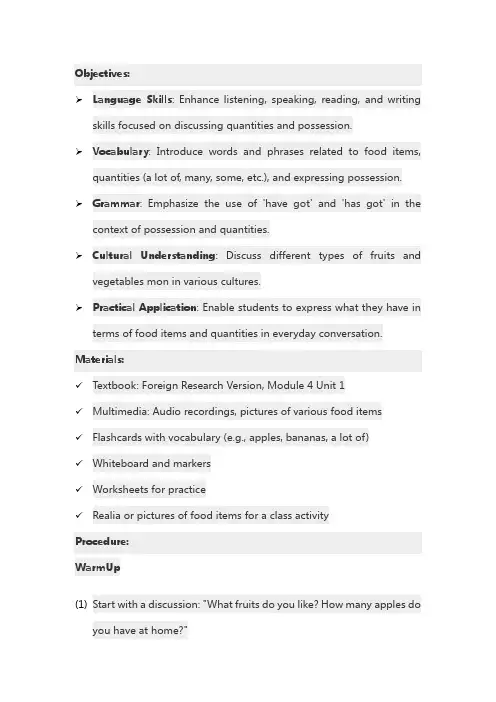
Objectives:➢Language Skills: Enhance listening, speaking, reading, and writing skills focused on discussing quantities and possession.➢Vocabulary: Introduce words and phrases related to food items, quantities (a lot of, many, some, etc.), and expressing possession.➢Grammar: Emphasize the use of 'have got' and 'has got' in the context of possession and quantities.➢Cultural Understanding: Discuss different types of fruits and vegetables mon in various cultures.➢Practical Application: Enable students to express what they have in terms of food items and quantities in everyday conversation. Materials:✓Textbook: Foreign Research Version, Module 4 Unit 1✓Multimedia: Audio recordings, pictures of various food items✓Flashcards with vocabulary (e.g., apples, bananas, a lot of)✓Whiteboard and markers✓Worksheets for practice✓Realia or pictures of food items for a class activityProcedure:WarmUp(1)Start with a discussion: "What fruits do you like? How many apples doyou have at home?"(2)Introduce the concept of expressing quantities and possession.Presentation1)Introduce new vocabulary using flashcards and images.2)Play the audio recording from the textbook for students to listen andrepeat.3)Explain the grammar point: 'have got' and 'has got' for possessionand quantities.Practice(1)Distribute worksheets with exercises on 'have got' and 'has got'.(2)Conduct a matching activity where students match food items withtheir quantities.Production1)In pairs, students conduct a survey asking about the food items andquantities their classmates have at home.2)Encourage the use of the new vocabulary and grammar structures.Interactive ActivityOrganize a "Food Inventory" game where students use 'have got' or 'has got' to describe the quantity of food items displayed in pictures or realia.Conclusion and Homework(1)Summarize the key vocabulary and grammar points learned.(2)For homework, ask students to write a short paragraph about thefood items they have at home, using 'have got' and 'has got'.(3)Address any questions and clarify doubts.Assessment:1)Monitor students' ability to use 'have got' and 'has got' correctlyduring the pair work and interactive activities.2)Evaluate the worksheets and homework for understanding andcorrect use of grammar and vocabulary.Reflection:❖Reflect on the effectiveness of the activities in teaching the grammar and vocabulary related to quantities and possession.❖Note any areas of difficulty for students and plan for additional practice or clarification in future lessons.。
Module 4 Healthy foodUnit 1 We’ve got lots of apples.教學目標【知識與技能】1. 能正確使用下列單詞和短語:food, drink, candy, fruit, meat, vegetable, apple, bean, beef, carrot, chicken, chocolate, coffee, cola, juice, milk, potato, tea, tomato,water, shop, have, get, have got, some, much, kind, so, has, bad, go shopping, lots of,too much2. 能聽懂關於食物和飲料的對話。
3. 能掌握have got的肯定句、否定句、疑問句及其回答。
4. 能談論自己喜歡的食品、健康食品以及購買食物。
【情感、態度與價值觀】讓學生學會區分健康食品與垃圾食品,培養學生形成良好的飲食習慣,擁有強健的體魄。
教學重難點【教學重點】掌握have got的肯定句、否定句、疑問句及其回答. 並能運用have got來談論食物、飲料。
【教學難點】掌握have got的肯定句、否定句、疑問句及其回答. 並能運用have got來談論食物、飲料。
教學過程Step 1 Warming-up1. Show some pictures of food and drink. Say what they are.2. Look at the pictures. Label the food and drink.Answers:1. fruit2. meat3. vegetables4. drinka. melonb. applec. oranged. chickene. porkf. beefg. tomatoh. potato i. carrot j. onion k. water l. milk m. juice3. Read the words after the teacher.4. Introduce the new words.Step 2 Listening practice1. Ask the students to listen to the recording and focus on the shopping list.2. Play the recording again, then they can check their answer with a partner.3. Check (√)the food and drink Betty and her mother have got.4. Call back the answer from the whole class and check the answer.5. Learning to learn. Ask the students to remember and write words they learn in groups.1) Fruit: apple, orange…2) Meat: beef, chicken, fish…Step 3 Listen and read.1. Ask the students to read the conversation silently.2. Play the recording and ask the students to listen and read the conversation.3. Read the conversation.4. Act it out.Step 4 Complete the table.1. Ask the students to complete the table.2. Ask the students to check with a partner.3. Play the recording again. Check the answers:Step 5 Work in pairAsk the students to talk about Tony’s shopping.— Has he got any chicken?—No, he hasn’t.Step 6 Listen and repeat.1. Play the recording once without stopping.2. Play the recording again and stop at the end of each line. Ask the whole class to repeat.3. Play the recording again and stop at the end of each line. Ask individual students to repeat.4. Ask the students to practice the sounds in pairs.Step 7 Work in pairs.Make a shopping list. Ask and say what you’ve got.1. The students should choose the words secretly and not tell anyone.2. Read through the example with the class.3. Pair them to ask and answer.4. Circulate and monitor their production.Step 8 Important and difficult points.A.重點短語:1. have/has got 擁有2. go shopping 去買東西;去購物3. let’s do sth. 讓我們去做某事4. too much 太多5. too many 太多6. lots of 許多7. be good for 對……有益8. be bad for 對……有害9. How about…? ……好嗎?……行嗎?B.重要知識點:1. some和any的用法1) some和any 既可以修飾可數名詞又可以修飾不可數名詞,some常用在肯定句中,而any則常用在否定和疑問句中。
We’ve got lots of apples 教案教学设计一、教学目标:1. 知识目标:学生能够理解并运用核心句型"We’ve got lots of apples." 进行交流。
学生能够掌握与苹果相关的基本词汇,如:apple, orange, banana, etc.2. 技能目标:学生能够在图片或实物的帮助下,正确使用核心句型进行简单的询问和回答。
学生能够通过小组合作,完成果园的场景设计。
3. 情感目标:培养学生对水果的喜爱,提高他们的健康饮食意识。
二、教学重难点:1. 教学重点:学生能够正确地使用核心句型"We’ve got lots of apples." 进行交流。
学生能够掌握与苹果相关的基本词汇。
2. 教学难点:学生能够在实际情境中灵活运用所学知识进行交流。
学生能够正确地使用水果词汇进行问答。
三、教学方法:情境教学法:通过设置果园的场景,让学生在真实的情境中学习水果词汇和核心句型。
游戏教学法:通过水果接龙、水果分类等游戏,激发学生的学习兴趣,巩固所学知识。
合作学习法:通过小组合作完成果园场景设计,培养学生的团队协作能力。
四、教学过程:1. 热身(5分钟)教师带领学生唱一首关于水果的英文歌曲,如"Fruit Salad" ,活跃课堂气氛。
2. 引入(10分钟)教师向学生展示一些水果图片,引导学生用中文说出水果名称,用英文重复。
教师出示一张苹果图片,引导学生用英文说出"We’ve got lots of apples." ,进而引入本课主题。
3. 新课呈现(15分钟)教师出示水果实物或图片,引导学生用英文描述水果,如"We’ve got lots of apples."教师引导学生进行水果分类游戏,巩固水果词汇。
4. 练习巩固(15分钟)学生分组进行角色扮演,运用核心句型进行水果购买对话。
教学设计模板Pre-task 1.Show some pictures and thingsto get the students to say outthe new words quickly.2.Ask the Ss to look at thepictures and talk aboutthem.(Activity1)3.Ask the Ss to label the food inthe pictures with the words fromthe boxes.(Activities2,3)4.Play a guessing game. Let theSs play a guessing game..Guessout:What’s in the fridge?Use thesentence:Have you got any…及ppt上的食物、饮料的名称,从而引导学生学习新词汇,然后以猜的游戏形式巩固词汇和学习新句型,通过图片、情景学单词,做到词不离句。
Step Three While-task Task2:listening(1)Play the tape,ask students tolisten and check(∨)the food anddrink Betty and her mother havegot.(Activity4) (2)Work inpair .They’ve got.../Theyhaven’t got...Task3:Listening and Reading(1)Tell students they are goingto listen to Tony and his fathertalking about going shopping andcomplete the table.(Activity5)(2)Organize the students to readthe conversation with the video.(3)Ask the Ss to work with theirgroups .Has he got any...?(4)Fill in the blanks.Task4:Solve the language points(1)Organize students to come tothe blackboard and show out somedifficult language points thatthey found.(2)Help the students to solvethe difficult points.利用听读,练习的方式加强学生对课文的理解,培养学生细节听力的技巧,能够听取信息,训练和培养学生细节听力技巧。
初中英语-外研版-七年级上册-Module 4 Unit1 we’ve got lots ofapples教案、教学设计Teaching aims:Knowledge aim:Students can get familiar with some phrases and sentence patterns: let’s go shopping for..., how about..., food and drink, be good for,etc.Ability aims:Students can understand the meaning of the dialogue through listening.Students can make new dialogue about going shopping.Emotional aim:Students will feel the happiness of speaking English and will be more confident in speaking English.Teaching key points and difficult points:Key points:Students will have a firm grasp of new phrases and sentence patterns.Students can apply listening strategies: making prediction, extensive listening and intensive listening.Difficult point:Students can make a role play of a short dialogue in a specific situation.Teaching procedures:Step 1 Lead-inGreet students and show a picture of fridge whose door is open. Ask students a question “what can you see in this picture?”.(Justification: A description of that picture helps students learn more words about food, which will make preparation for the following study.In addition, today’s topic is introduced into the class. )Step 2 Pre-listeningBased on previous step, teacher use questions and hints as well as pictures showed in lead-in part to introduce new phrases and sentence patterns:let’s go shopping for..., how about..., food and drink, be good for,etc.(Justification: This step helps students clear obstacles. Students will understand the following dialogue better.) Tell students that fridge is our good friend Tony’s, and there is something happen to Tony’s fridge, can you make a prediction on what happened to Tony’s fridge?(Justification: A prediction will easily get students’attention, which can stimulate students’imagination and creation and create a nice learning atmosphere.)Step 3 While-listeningActivity 1:extensive-listeningAsk students to listen to the dialogue for the first time, and check their prediction.Then ask students “ what’s the dialogue mainly talking about?”(Justification: Students will grasp the main idea of that dialogue quickly, meanwhile they check their prediction.) Activity 2:intensive-listening1.Ask students to listen to the dialogue for the second time, this time they should pay more attention to some detail information. Give students 5 minutes to fill the chart and check together.2.Propose another two questions for students to answer.(1) Will Tony get cola or tea?__________________________________________(2) What will Tony’s Dad get?__________________________________________(Justification:Student will have a deeper understanding about this dialogue, furthermore this dialogue will help students move to the next step.)3. Play the dialogue for the third time, ask students to read after the listening material, meanwhile focus on their pronunciation and intonation.(Justification: This step helps students correct their pronunciation and intonation.)Step 4 post-listeningGive students 10 minutes to role play the dialogue, one student acts Tony’s father, another student acts Tony. Students can add any plot they can image, they can use words which they came up in warming up part.Students could write down their plot, then two students in a group act their dialogue out.(Justification: This activity can improve students’comprehensive ability, whether speaking or acting. Moreimportantly, students will acquire happiness in learning English.)Step 5 Summary and homeworkSummary: Invite one student to summarize what we have learned today.Homework: Ask students to search more useful phrase and sentence patterns, which can be used in shopping topic.Blackboard design:。
M4U1Wevegotlotsofapples说课稿M4U1 We’ve got lots of apples. 说课稿一、教材分析:本单元是第四模块的第一课,也是听说课。
教学目标:1、知识目标:能认读水果和蔬菜类词汇food, drink, candy, meat,vegetable,apple,bean,beef,carrot,chicken,chocolate,coffee, cola, juice, milk, potato, tea, tomato, water, shop, tea, tomato, water,shop, have, get, some, much, kind, so, has, bad.并能正确使用本节课的基本句型;2. 能力目标:能灵活地运用所学的知识解决实际生活中遇到的问题即达到用英语进行交流的目的。
3、情感目标:鼓励学生勇敢地使用英语,每天应吃健康食品。
教学重点:水果、蔬菜、饮料单词的掌握及have/has got句型的掌握教学难点;have/has got句型的的用法二、学情分析:本单元的主题是谈论水果、蔬菜和饮料方面的购物计划,围绕这一主题进行一系列的交际活动,我班大部分学生对于蔬菜和水果应该不成问题。
但是对于have/has got句型肯定句,否定句和疑问句的运用还不够熟练,需要操练。
所以在课堂上我设计了Pair Work这项活动,以提高综合运用语言的能力。
但效果不是很好,我也安排了练习,但由于时间紧,没能练习,下节课准备再操练三、教法和学法:运用Communicative teaching method交际教学法使学生通过参与、合作等途径学习词汇和句子的表达。
四、教具:电脑,课件五、教学过程:Step 1 Warm-up1. Do you like fruit? What kind of fruit do you like ? Do you like vegetables?What kind of vegetables do you like?Step 2 presentation1. Learn the new words: (利用Flash课件,将水果、蔬菜和饮料类单词直观地呈现给学生们)2. Listening:(本部分我共设计了两个听力练习,第一个是听录音选择贝蒂和妈妈所有的食品和饮料,我觉得本项听力练习应该是挺简单的,但学生可能没理解题意,部分学生没听懂,最后还是全班同学一起说的答案。